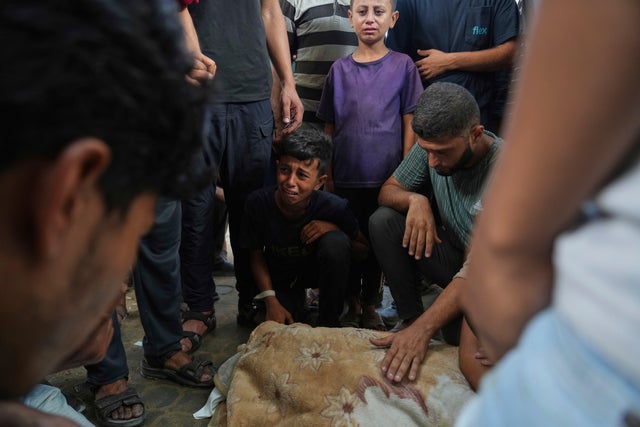The latest child to starve to death in Gaza weighed less than when she was born – AP News

Humanitarian Crisis in Gaza: A Failure to Uphold Sustainable Development Goals
A severe humanitarian crisis is unfolding in the Gaza Strip, marked by widespread starvation and a breakdown of essential services. This situation represents a catastrophic failure to meet fundamental human needs and a direct contravention of several United Nations Sustainable Development Goals (SDGs), particularly those concerning hunger, health, and peace.
Case Study: The Death of Zainab Abu Halib
Medical Details and the Negation of SDG 3 (Good Health and Well-being)
The recent death of 5-month-old Zainab Abu Halib in Khan Younis exemplifies the crisis. Her case highlights a complete collapse of the safeguards outlined in SDG 3, which aims to ensure healthy lives and promote well-being for all at all ages. The infant’s death was preventable, directly resulting from the unavailability of essential medical and nutritional supplies.
- Cause of Death: Diagnosed by medical professionals as “severe, severe starvation.”
- Medical Condition: The infant required a specialized formula for a cow’s milk allergy. The lack of this formula led to chronic diarrhea, vomiting, a compromised immune system, and ultimately, a fatal bacterial infection and sepsis.
- Physical Deterioration: At birth, Zainab weighed over 3 kilograms (6.6 pounds). At the time of her death, her weight had fallen to less than 2 kilograms (4.4 pounds).
This single case is a stark illustration of the failure to achieve SDG Target 3.2: to end preventable deaths of newborns and children under five years of age.
Socio-economic Context and SDG 1 (No Poverty)
The family’s circumstances underscore the challenges related to SDG 1. As a displaced family living in a tent, they lack the basic resources, shelter, and stability necessary to protect their most vulnerable members. The mother, Esraa Abu Halib, also suffers from malnutrition, demonstrating how the crisis exacerbates poverty and vulnerability across generations.
Widespread Malnutrition and the Violation of SDG 2 (Zero Hunger)
The death of Zainab Abu Halib is not an isolated incident but a symptom of a systemic food crisis that directly violates SDG 2, which seeks to end hunger, achieve food security, improve nutrition, and promote sustainable agriculture. Current conditions in Gaza indicate a severe regression from this goal.
Escalating Malnutrition Statistics
Data from the territory’s Health Ministry reveals a grim and worsening trend, fundamentally undermining SDG Target 2.2 (to end all forms of malnutrition).
- Total Malnutrition-Related Deaths: 127 individuals.
- Child Malnutrition-Related Deaths: 85 children.
Healthcare System Under Strain
The healthcare infrastructure is overwhelmed, further impeding progress on SDG 3.
- Dr. Ahmed al-Farah, head of the pediatric department at Nasser Hospital, reports a surge in acute malnutrition cases, with his 8-bed department currently treating approximately 60 children.
- An affiliated malnutrition clinic is receiving an average of 40 new cases weekly.
- Medical professionals warn that without the immediate opening of crossings for food and specialized formula, the number of child deaths will rise to unprecedented levels.
Systemic Failures in Aid and Governance: Contravening SDG 16 and SDG 17
Restrictions on Humanitarian Aid
The primary driver of the crisis is the severe restriction on humanitarian aid. This blockade prevents the partnerships and resource mobilization essential for achieving the SDGs, as outlined in SDG 17 (Partnerships for the Goals).
- Aid Requirement: The U.N. states that 500 to 600 trucks of aid are needed daily to meet the population’s basic needs.
- Actual Aid Delivery: Since May, an average of only 69 trucks per day has been permitted entry.
- Distribution Challenges: The U.N. reports that much of the aid that does enter cannot be distributed effectively due to security issues, including interception by hungry crowds and gangs.
Breakdown of Peace and Justice (SDG 16)
The ongoing conflict and the use of starvation as a consequence of war are in direct opposition to SDG 16 (Peace, Justice and Strong Institutions). The failure to protect civilians, particularly children, and ensure their access to life-saving resources represents a profound breakdown of international humanitarian principles. While Israel’s foreign ministry has rejected accusations of “starvation propaganda,” the on-the-ground reality reported by medical staff and aid agencies points to a deepening humanitarian catastrophe that demands immediate and effective international intervention to realign with the global commitment to the Sustainable Development Goals.
1. Which SDGs are addressed or connected to the issues highlighted in the article?
- SDG 2: Zero Hunger – The article’s central theme is the death of an infant from starvation and widespread malnutrition in Gaza due to a lack of food and specialized formula.
- SDG 3: Good Health and Well-being – The report details the death of a child, the health consequences of malnutrition (sepsis, weakened immune system), and the overwhelming of healthcare facilities.
- SDG 16: Peace, Justice and Strong Institutions – The underlying cause of the hunger and health crisis is identified as the ongoing war, restrictions on aid, and violence against civilians seeking food.
2. What specific targets under those SDGs can be identified based on the article’s content?
SDG 2: Zero Hunger
- Target 2.1: “By 2030, end hunger and ensure access by all people, in particular the poor and people in vulnerable situations, including infants, to safe, nutritious and sufficient food all year round.”
- The article directly addresses this target by highlighting the death of a 5-month-old infant, Zainab, from starvation. It states she died due to a lack of access to essential food, specifically a “special baby formula which did not exist in Gaza.” The article also notes that “Much of Gaza’s population now relies on aid,” indicating a widespread lack of access to sufficient food.
- Target 2.2: “By 2030, end all forms of malnutrition…”
- The article explicitly focuses on malnutrition. A doctor is quoted as saying Zainab’s death was a case of “severe, severe starvation.” It also mentions that “85 children to die of malnutrition-related causes in Gaza during the war” and that the mother “has suffered from malnutrition.” The pediatric department is described as treating “about 60 cases of acute malnutrition.”
SDG 3: Good Health and Well-being
- Target 3.2: “By 2030, end preventable deaths of newborns and children under 5 years of age…”
- Zainab’s death at 5 months old is a clear example of a preventable death of a child under 5. The article states that the lack of formula led to her death, which could have been prevented with adequate supplies. The statistic of “85 children to die of malnutrition-related causes” further underscores the failure to meet this target in the region.
- Target 3.8: “Achieve universal health coverage, including… access to quality essential health-care services and access to safe, effective, quality and affordable essential medicines and vaccines for all.”
- The article demonstrates a lack of access to essential healthcare supplies. Zainab needed a “special type of formula that helps with babies allergic to cow’s milk,” which is an essential medical/nutritional supply that was unavailable. The doctor warns that unless “food and baby formula are allowed in,” more deaths will occur. Furthermore, the pediatric department is overwhelmed, with “a capacity of eight beds” but “treating about 60 cases,” indicating a collapse in the capacity to provide quality healthcare services.
SDG 16: Peace, Justice and Strong Institutions
- Target 16.1: “Significantly reduce all forms of violence and related death rates everywhere.”
- The article frames the crisis within the context of “21 months of war and Israeli restrictions on aid.” The deaths from starvation are a direct result of the conflict and the blockade. The article also provides a stark statistic of direct violence: “More than 1,000 Palestinians have been killed by Israeli forces since May while trying to get food,” which is a direct measure of violence-related death rates.
3. Are there any indicators mentioned or implied in the article that can be used to measure progress towards the identified targets?
Indicators for SDG 2 (Zero Hunger)
- Prevalence of undernourishment/malnutrition: The article provides specific numbers, stating a hospital’s pediatric department is treating “about 60 cases of acute malnutrition” and another clinic “receives an average of 40 cases weekly.” The doctor’s diagnosis of “severe, severe starvation” is a qualitative indicator.
- Prevalence of wasting in children under 5 years of age: Zainab’s weight loss is a direct indicator of wasting. The article notes she “weighed over 3 kilograms (6.6 pounds) when she was born. When she died, she weighed less than 2 kilograms (4.4 pounds).”
Indicators for SDG 3 (Good Health and Well-being)
- Under-5 mortality rate: The article provides a direct number that contributes to this indicator: “85 children to die of malnutrition-related causes in Gaza during the war.”
- Health service capacity and access: The article indicates a severe lack of capacity by stating the pediatric department has “a capacity of eight beds” but is treating “about 60 cases.” The unavailability of “special baby formula” serves as an indicator for lack of access to essential medical supplies.
Indicators for SDG 16 (Peace, Justice and Strong Institutions)
- Number of civilian deaths in armed conflict: The article provides a direct statistic: “More than 1,000 Palestinians have been killed by Israeli forces since May while trying to get food.” The 127 deaths from malnutrition are also conflict-related deaths.
- Access to humanitarian aid: The article indicates severe restrictions on aid, noting that the “average of 69 trucks a day… is far below the 500 to 600 trucks a day the U.N. says are needed.” This serves as an indicator of the functionality of humanitarian corridors in a conflict zone.
4. Table of SDGs, Targets, and Indicators
| SDGs | Targets | Indicators Identified in the Article |
|---|---|---|
| SDG 2: Zero Hunger | 2.1: End hunger and ensure access to safe, nutritious and sufficient food for all, especially infants.
2.2: End all forms of malnutrition. |
|
| SDG 3: Good Health and Well-being | 3.2: End preventable deaths of newborns and children under 5.
3.8: Achieve universal health coverage and access to essential medicines. |
|
| SDG 16: Peace, Justice and Strong Institutions | 16.1: Significantly reduce all forms of violence and related death rates. |
|
Source: apnews.com

What is Your Reaction?
 Like
0
Like
0
 Dislike
0
Dislike
0
 Love
0
Love
0
 Funny
0
Funny
0
 Angry
0
Angry
0
 Sad
0
Sad
0
 Wow
0
Wow
0


































































.jpg?#)






